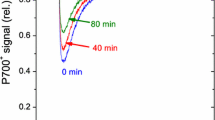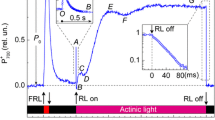Abstract
Maize (Zea mays L.) inbred lines of contrasting chilling sensitivity (three tolerant, three sensitive lines) were acclimated to 280 μmol photons m−2 s−1 white light at a 17°C sub-optimal temperature. They showed no symptoms of photoinhibition, despite slight changes in photosystem II (PSII) fluorescence and thermoluminescence properties in two tolerant lines. A luminescence “afterglow” emission [Bertsch and Azzi (1965) Biochim Biophys Acta 94:15–26], inducible by a far-red (FR) illumination of unfrozen leaf discs, was detected either as a bounce in decay kinetics at constant temperatures or as a sharp thermoluminescence afterglow band at about 45°C, in dark-adapted leaves. This band reflects the induction by warming of an electron pathway from stromal reductants to plastoquinones and to the QB secondary acceptor of PSII, resulting in a luminescence-emitting charge recombination in the fraction of centres that were initially in the S2/3QB non-luminescent state. A 5-h exposure of plants to growth chamber light shifted this luminescence emission towards shorter times and lower temperatures for several hours in the three chilling-tolerant lines. This downshift was not observed, or only transiently, in the three sensitive lines. In darkness, the downshifted afterglow band relaxed within hours to resume its dark-adapted location, similar for all maize lines. A faster dark re-reduction of P700+ oxidized by FR light (monitored by 820-nm absorbance) and an increase of photochemical energy storage under FR excitation (determined by photoacoustic spectroscopy) confirmed that a cyclic pathway induced by white actinic light remained activated for several hours in the tolerant maize lines.






Similar content being viewed by others
Abbreviations
- DCMU:
-
3-(3′,4′-Dichlorophenyl)-1,1-dimethylurea (diuron), an inhibitor of photosystem II that binds to the QB pocket
- E a :
-
Apparent activation energy (enthalpy) of charge recombination
- 1F, 2F:
-
1 or 2 flashes
- FQR:
-
Ferredoxine-plastoquinone-reductase
- F0, FV, FM:
-
Basal, variable and maximal chlorophyll fluorescence levels
- PSI:
-
Photosystem I
- PSII:
-
Photosystem II
- QB:
-
Secondary quinonic acceptor of photosystem II
- NDH:
-
NAD(P)H dehydrogenase (plastoquinone reductase)
- R, S:
-
Chilling-tolerant and sensitive maize lines
- TL:
-
Thermoluminescence
- T m :
-
Temperature maximum of a thermoluminescence band
References
Albertsonn PA (2001) A quantitative model of the domain structure of the photosynthetic membrane. Trends Plant Sci 8:349–354
Allen DJ, Ort DR (2001) Impacts of chilling temperatures on photosynthesis in warm-climate plants. Trends Plant Sci 6:36–42
Arnon DI (1959) Conversion of light into chemical energy in photosynthesis. Nature 184:10–21
Barth C, Krause GH (2002) Study of tobacco transformants to assess the role of chloroplastic NAD(P)H dehydrogenase in photoprotection of photosystems I and II. Planta 216:273–279
Bendall DS, Manasse RS (1995) Cyclic photophosphorylation and electron transport. Biochim Biophys Acta 1229:23–38
Bennoun P (1982) Evidence for a respiratory chain in the chloroplast. Proc Natl Acad Sci USA 79:4352–4356
Bergantino E, Dainese P, Cerovic Z, Sechi S, Bassi R (1995) A post-translational modification of the photosystem II subunit CP29 protects maize from cold stress. J Biol Chem 270:8474–8481
Bertsch WF, Azzi JR (1965) A relative maximum in the decay of long-term delayed light emission from the photosynthetic apparatus. Biochim Biophys Acta 94:15–26
Blondon F, Clabault G, Rainguez M (1981) Déplacement de l’optimum thermique de l’activité photosynthétique, sous l’action d’un traitement à température fraîche (10°C), chez le maïs: différenciation de deux variétés. C R Acad Sci Paris Ser III 292:149–152
Briantais JM, Ducruet JM, Hodges M, Krause GH (1992) Effects of high light at chilling temperature on photosystem II in spinach leaves. Photosynth Res 31:1–10
Bukhov N, Carpentier R (2004) Alternative photosystem-I driven electron transport routes: mechanisms and functions. Photosynth Res 82:17–33
Bukhov N, Egorova E, Carpentier R (2002) Electron flow to photosystem I from stromal reductants in vivo: the size of the pool of stromal reductants controls the rate of electron transport donation to both rapidly and slowly reducing photosystem I units. Planta 215:812–820
Bukhov NG, Govindachary S, Rajagopal S, Joly D, Carpentier R (2004) Enhanced rates of P700+ dark-reduction in leaves of Cucumis sativus L. photoinhibited at chilling temperature. Planta 218:852–861
Cardol P, Gloire G, Havaux M, Remacle C, Montagne R, Franck F (2003) Photosynthesis and state transitions in mitochondrial mutants of Chlamydomonas reinhardtii affected in respiration. Plant Physiol 133:2010–2020
Constantin-Roman M (2000) Etude spectroscopique des effets de stress thermique sur la membrane photosynthétique: relations avec les données écophysiologiques. Thesis. Universities Paris-Sud-Orsay and Bucarest, 15 December 2000
Cornic G, Bukhov NG, Wiese C, Bligny R, Heber U (2000) Flexible coupling between light-dependent electron and vectorial proton transport in illuminated C3 plants. Role of photosystem I-dependent proton puming. Planta 210:468–477
Ducruet JM (2003) Chlorophyll thermoluminescence of leaf discs: simple instruments and progress in signal interpretation open the way to new ecophysiological indicators. J Exp Bot 54:2419–2430
Ducruet JM, Janda J, Paldi E (1997) Whole leaf thermoluminescence as a prospective tool for monitoring intraspecific cold tolerance in crop species. Acta Agron Hung 45:463–466
Feild TS, Nedbal N, Ort DR (1998) Nonphotochemical reduction of the plastoquinone pool in sunflower leaves originates from chlororespiration. Plant Physiol 116:1209–1218
Finazzi G, Barbagallo RP, Bergo E, Barbato R, Forti G (2001) Photoinhibition of Chlamydomonas reinhardtii in state 1 and state 2. J Biol Chem 276:22251–22257
Finazzi G, Rappaport F, Furia A, Fleischmann M, Rochaix JD, Zito F, Forti G (2002) Involvement of state transitions in the switch between linear and cyclic electron flow in Chlamydomonas reinhardtii. EMBO Rep 31(31):280–285
Foyer CH, Vanacker H, Gomez LD, Harbinson J (2002) Regulation of photosynthesis and antioxidant metabolism in maize leaves at optimal and chilling temperature: review. Plant Physiol Biochem 40:659–668
Garab G, Lajko F, Mustardy L, Marton L (1989) Respiratory control over photosynthetic electron transport in chloroplasts of higher-plant cells: evidence for chlororespiration. Planta 179:349–358
Haldimann P, Fracheboud Y, Stamp P (1996) Photosynthetic performance and resistance to photoinhibition of Zea mays L. leaves grown at sub-optimal temperature. Plant Cell Environ 19:85–92
Havaux M (1987) Effect of chilling on the redox state of the primary electron acceptor QA of photosystem II in sensitive and resistant plant species. Plant Physiol Biochem 25:735–748
Havaux M (1993) Characterization of thermal damage to the photosynthetic electron transport system in potato leaves. Plant Sci 94:19–33
Havaux M (1996) Short-term responses of photosystem I to heat stress. Photosynth Res 47:85–97
Hayden DB, Covello PS, Baker NR (1988) Characterization of a 31 kDa polypeptide that accumulates in the light-harvesting apparatus of maize leaves during chilling. Photosynth Res 15:257–270
Heber U, Gerst U, Krieger A, Neimanis S, Kobayashi Y (1995) Coupled cyclic electron transport in intact chloroplasts and leaves of C3 plants: does it exists? if so, what is its function? Photosynth Res 46:269–273
Janda T, Szalai G, Ducruet JM, Paldi E (1998) Changes in photosynthesis in inbred maize lines lines with different degrees of chilling tolerance grown at optimum and suboptimum temperatures. Photosynthetica 36:205–212
Janda T, Szalai G, Giauffret C, Paldi E, Ducruet JM (1999) The thermoluminescence ‘afterglow‘ band as a sensitive indicator of abiotic stresses in plants. Z Naturforsch 54c:629–633
Janda T, Szalai G, Paldi E (2000) Thermoluminescence investigation of low temperature stress in maize. Photosynthetica 38:635–639
Joët T, Cournac L, Peltier G, Havaux M (2002) Cyclic electron flow around photosystem I in C3 plants. In vivo control by the redox state of chloroplasts and involvement of the NADH-dehydrogenase complex. Plant Physiol 128:760–769
Kim S-J, Lee C-H, Hope AB, Chow WS (2001) Inhibition of photosystems I and II and enhanced back flow of photosystem I electrons in cucumber leaf discs chilled in the light. Plant Cell Physiol 42:842–848
Krieger A, Bolte S, Dietz KJ, Ducruet JM (1998) Thermoluminescence studies on the facultative CAM plant Mesembryanthenum crystallinum L. Planta 205:587–594
Lajko F, Kadioglu A, Borbely G, Garab G (1997) Competition between the photosynthetic and the (chloro)respiratory electron transport chains in cycanobacteria, green algae and higher plants. Effect of heat stress. Photosynthetica 33:217–226
Li XG, Duan W, Meng QW, Zou Q, Zhao SJ (2004) The function of chloroplastic NAD(P)H dehydrogenase in tobacco during chilling stress under low irradiance. Plant Cell Physiol 45:103–108
Malkin S, Canaani O (1994) The use and the characteristics of the photoacoustic method in the study of photosyntheszis. Annu Rev Plant Physiol 45:493–526
Mauro S, Dainese P, Lannoye R, Bassi R (1997) Cold-resistant and cold-sensitive maize lines differ in the phosphorylation of the photosystem II subunit CP29. Plant Physiol 115:171–180
Messner MM, Melchinger AE, Hermann RG, Boppenmaier J (1993) Relationship among early european maize inbreds II. Comparison of pedigree and RFLP data. Crop Sci 33:944–950
Miranda T, Ducruet JM (1995) Characterization of the chlorophyll thermoluminescence afterglow in dark-adapted or far-red-illuminated plant leaves. Plant Physiol Biochem 33:689–699
Munekage Y, Hoja M, Meurer J, Endo T, Tasaka M, Shikamai T (2002) PGR5 is involved in cyclic electron flow around photosystem I and is essential for photoprotection in Arabidopsis. Cell 110:361–371
Nakamoto I, Sundblad L-G, Garderström P, Sundbom E (1988) Far-red stimulated long-lived luminescence from barley protoplasts. Plant Sci 55:1–7
Peltier G, Cournac L (2002) Chlororespiration. Annu Rev Plant Physiol 53:523–550
Pursiheimo S, Martinsue P, Rintamaki E, Aro EM (2003) Photosystem II protein phosphorylation follows four distinctly different regulatory patterns induced by environmental cues. Plant Cell Environ 26:1995–2003
Quiles MJ, Lopez NJ (2004) Photoinhibition of photosystems I and II induced by the exposure to high light intensity during oat plant growth—effect of the chloroplast NADH complex. Plant Sci 166:615–823
Ravenel J, Peltier G, Havaux M (1994) The cyclic electron pathway around photosystem-I in Chlamydomonas reinhardtii as determined in vivo by photoacoustic measurements of energy storage. Planta 193:251–259
Rozak PR, Seser RM, Wacholtz WE, Wise RR (2002) Rapid, reversible alterations in spinach thylakoids appression upon changes in light intensity. Plant Cell Environ 25:421–429
Rutherford AW, Inoue YY (1984) Oscillations of delayed luminescence from PSII: recombination of S2Q −B and S3Q −B . FEBS Lett 165:163–170
Sane PV, Ivanov AG, Hurry V, Huner NPA, Oquist G (2003) Changes in the redox potential of primary and secondary electron-accepting quinones in photosystem II confer increased resistance to photoinhibition in low-temperature-acclimated Arabidopsis. Plant Physiol 132:2144–2151
Scheller HV (1996) In vitro cyclic electron transport in barley thylakoids follows two independent pathways. Plant Physiol 110:187–194
Schreiber U, Berry JA (1977) Heat-induced changes in chlorophyll fluorescence in intact leaves correlated with damage to the photosynthetic apparatus. Planta 136:233–238
Schreiber U, Klughammer C, Neubauer C (1988) Measuring P700 absorbance changes around 830 nm with anew type of pulse modulation system. Z Naturforsch 43c:686–698
Shikanai T, Endo T, Hashimoto T, Yamada Y, Asasa K, Yokota A (1998) Directed disruption of the tobacco ndhB gene impairs cyclic electron flow around photosystem I. Proc Natl Acad Sci USA 95:9705–9709
Sundblad L-G, Schröder WP, Akerlung HE (1988) S-state distribution and redox state of QA in barley in relation to luminescence decay kinetics. Biochim Biophys Acta 973:47–52
Sundby C, Melis A, Mäenpää P, Andersson B (1986) Temperature-dependent changes in the antenna size of photosystem II. Reversible conversion of photosystem IIα to photosystem IIβ. Biochim Biophys Acta 851:475–483
Weis E (1984) Short term acclimation of spinach to high temperatures. Plant Physiol 74:402–407
Acknowledgements
This work was supported by a ACC-SV grant from the Ministry of Research and Technology and by the Comité Technique Permanent de la Sélection (CTPS). The Mumm-Perrier-Jouët company provided initial support to investigate spring chilling in grapevine. Seeds of the 1872 and 1192 inbred lines were kindly given by Euralis. We thank Dr. Sridharan Govindachary for the critical review of the manuscript.
Author information
Authors and Affiliations
Corresponding author
Rights and permissions
About this article
Cite this article
Ducruet, JM., Roman, M., Havaux, M. et al. Cyclic electron flow around PSI monitored by afterglow luminescence in leaves of maize inbred lines (Zea mays L.): correlation with chilling tolerance. Planta 221, 567–579 (2005). https://doi.org/10.1007/s00425-004-1464-6
Received:
Accepted:
Published:
Issue Date:
DOI: https://doi.org/10.1007/s00425-004-1464-6




